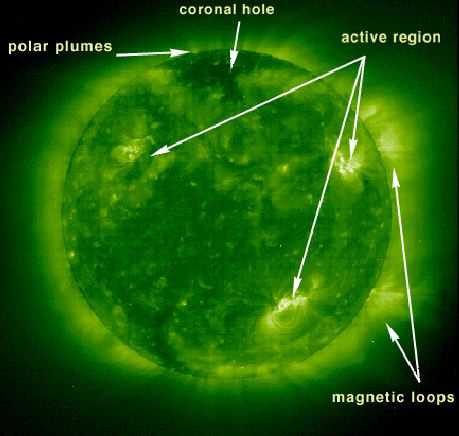See the Sun in Extreme Ultraviolet Light
 The Sun at 171 Å. |
 The Sun at 195 Å. |
 The Sun at 304 Å. |
Click any one of the images to see a larger version.
The wavelength of the light seen by the spacecraft in each photo is measured in angstroms. Angstrom is abbreviated with the symbol Å.
Angstrom is a unit of length equal to 10-8 cm. That's one-hundredth of a millionth of a centimeter. An angstrom is around the size of an atom.
The human eye can't see ultraviolet light. Thus, NASA changed the colors of these images so we can see them. To sort the images visually, NASA scientists assigned colors to EIT images recorded at particular extreme ultraviolet (EUV) wavelengths. They rendered the images in these colors:
-
171 Å. image in blue
195 Å. image in green
304 Å. image in orange.
-
Active Region is an area of the Sun where the magnetic fields are very strong. At ultraviolet and X-ray wavelengths they appear bright. In visible light they exhibit sunspots.
Corona is the outermost layer of the solar atmosphere consisting of a highly rarefied gas with a temperature greater than one million degrees Kelvin. It is visible to the naked eye during a solar eclipse.
Coronal Hole is an area of the corona which appears dark in X-rays and ultraviolet light. The holes usually are located at the poles of the Sun, but can occur at other places. The magnetic field lines in a coronal hole extend out into the solar wind rather than coming back down to the Sun's surface as they do in other parts of the Sun.
Coronal Mass Ejection is a huge magnetic bubble of plasma that erupts from the Sun's corona and travels through space at high speed.
Coronal Streamer is a large scale magnetic structure observed in the Sun's corona.
Filament is a structure in the Sun's corona consisting of cool plasma supported by magnetic fields. Filaments are dark structures when seen against the bright solar disk, but appear bright when seen over the solar limb (edge of the Sun). Filaments seen over the limb are also known as prominences.
Magnetic Field is a field of force that is generated by electric currents. The Sun's average large-scale magnetic field, like that of the Earth, exhibits a north and a south pole linked by lines of magnetic force.
Polar Plume is a bright structure of out-flowing gas which occurs along magnetic field lines in coronal holes. These field lines extend out into the Solar System. Although plumes usually occur at the Sun's poles, they can appear anywhere there is a coronal hole.
Prominence is a structure in the Sun's corona consisting of cool plasma supported by magnetic fields. Prominences are bright structures when seen over the solar limb, but appear dark when seen against the bright solar disk. Prominences seen on the disk also are known as filaments.
- Views of the Sun as seen by various watch dog satellites during the 'Bastille Day' event
- Sun and sunspots main page
- How sunspots affect radio signals
- Learn more about sunspots and their effects on Earth
| Read more Space Today Online stories about the Solar System | |||||
|---|---|---|---|---|---|
| Star: | The Sun | ||||
| Inner Planets: | Mercury | Venus | Earth | Mars | |
| Outer Planets: | Jupiter | Saturn | Uranus | Neptune | Pluto |
| Other Bodies: | Moons | Asteroids | Comets | ||
| Beyond: | Pioneers | Voyagers | |||
| Top of this page | Solar System main page | Space Today Online cover |